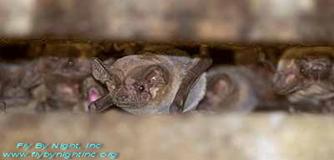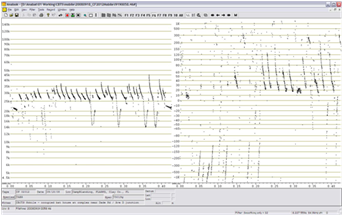
|
Fly By Night, Inc. is recognized by the IRS as a Section 501(c)(3) non-profit / tax-exempt organization. Donations are tax-deductible and all donated funds directly support our bat conservation efforts. CH12360
All content on this site is property of Fly By Night, Inc, and not to be duplicated for use without written permission |

|
LeConte’s Free-Tail, Tadarida brasiliensis cynocephala |

TABREcholocation: Highly variable, sometimes audible, particularly social calls. Some individual calls or short call sequences can be confused with EPFU and LAIN Florida Distribution: Peninsular FL Roosting Behavior: Colonial. Males sometimes solitary, TABR are a truly urban species In FL & the SE US, which adapted so well to roosting in structures (buildings, bridges, etc), they have all but abandoned the use of natural roosts. Colonies range in size from fewer than 100 to several thousand and can be identified by the distinct ‘sweet & musky’ odor. Often roost with EPFU, MYAU or NYHU. Foraging Behavior: Mostly moths Reproduction: Single pup born mid May - late June. Juveniles volant in 10 -12 weeks Management and Conservation Recommendations: TABR have been documented in buildings & bat house throughout the SE Would benefit most from the continued installation of bat houses and IPM practices designed to manage populations rather than control nuisance colonies. Approved exclusion methods are only the first step – the colony will simply move to a nearby structure without roost mitigation. Bat management guidelines that require physical exclusion methods, roost mitigation (installation of bat houses) and clearly prohibit the use of chemicals or poisons and maternity season exclusions. |


Tadarida brasiliensis (TABR) Anabat files recorded September 2008 |
|
Free Info |
|
What We Do |
|
Who We Are |
|
How To Help |
|
Take A Peek |
|
Live Bats |
|
Description—Measurements |
|||||
|
Mass g |
FA mm |
Wingspan |
Total length |
Tragus |
Calcar |
|
10 – 13 |
41.4 - 41.9 |
290 - 325 |
91 - 98 |
small, blunt |
present |
|
1/3 of tail protrudes beyond inter femoral membrane, short velvety fur, gray, brown or russet coloration, large squarish ears, wrinkled muzzle, long narrow wings |
|||||
|
Urban Bat Status |
|
Buildings |
BatHouses |
|
Yes |
Yes |
|
Status |
|||
FWS / USGS |
Florida |
FNAI |
IUCN |
|
none |
Common / abundant |
G5 |
NT |

